Howard Wight Marshall | |
|---|---|
 | |
| Born | 1944 (age 78–79) |
| Nationality | American |
| Occupation(s) | professor, fiddler |
| Known for | Missouri and Regional Art and Culture, especially fiddling |
| Academic background | |
| Alma mater | University of Missouri (BA) Indiana University (MA & PhD) |
| Academic work | |
| Institutions | University of Missouri |
Howard Wight Marshall (born 1944) is an American academic, author, folklorist, historian, and fiddler. He is a professor emeritus and former chair of the Department of Art History and Archeology at the University of Missouri in Columbia, Missouri.[1] In addition to his work on regional folk architecture he researches fiddling traditions in Missouri and the Ozarks, especially the style known as Missouri fiddling.[2] Marshall is the founding director of the Missouri Cultural Heritage Center. In 2018 he received the Missouri Humanities Council Distinguished Literary Award.[3]
Historical research
Howard Marshall’s work on historical topics like Missouri Fiddling are highly detailed and respected for their depth and scope, particularly in his detailed biographies. Some historians criticize Marshall’s work, stating that he omitted key analyses regarding cultural politics.[4] Both highly critical and more amicable reviews praise Marshall’s depth of study and ability to record and describe different types of folk music.[5] A significant amount of Marshall’s research is centered around folk music within Missouri. Of any singular topic, Marshall has written the most about Missouri fiddling and Missouri fiddlers generally and biographically.
Now That’s a Good Tune, Masters of Missouri Fiddling, details Missouri fiddling across various styles, contexts, and locations. Howard argues that the genesis of the modern Missouri fiddling style is rooted most strongly in Southern and South-Eastern British-American cultural regions of the late eighteenth and early nineteenth centuries.[6] This influence is heard throughout different geographic regions, which can be broadly sorted into North Missouri, Little Dixie, and the Ozark area. However, the style of Missouri fiddling has been influenced by the development of sheet music, radio, tune books, and television. The work describes the effect technological development as significant enough to warrant considering it as its own regional style.
In "Play Me Something Quick and Devilish : Old-Time Fiddlers in Missouri," Marshall argues that violin is the most important instrument in Missouri’s folk history before the end of the nineteenth century when piano and eventually guitar became more prominent. This is partly because it was much easier to travel with compared to other instruments. Other factors include the violin’s versatility across styles and its similarity to the human voice. Marshall describes the fiddle’s great musical flexibility allows it to vary greatly across numerous ethnic and cultural heritages, ranging from indigenous American influences to how jazz influenced certain fiddle styles in the twentieth century [7].
Though Marshall has written in detail on abstract cultural and geographical differences in fiddling, he focuses in detail on particular violinists to both characterize generalizations and show that there are always exceptions and bending of what is considered typical in great fiddler’s styles. Individual fiddlers’ styles change throughout their lives, and heritage is not always the primary determining factor in these musicians’ playing.
Works
- Folk Architecture in Little Dixie: a regional culture in Missouri (1981)
- Bucakroos in Paradise: Cowboy Life in Northern Nevada (1981)
- Missouri Artist Jesse Howard with a Contemplation on Idiosyncratic Art (1983)
- The German-American Experience in Missouri (1986)
- Paradise Valley, Nevada: The People and Buildings of an American Place (1995)
- Barns of Missouri: Storehouses of History (2003)
- Play Me Something Quick and Devilish: Old-Time Fiddlers in Missouri, Vol. 1 (2013)
- Fiddlers Dream: Old-Time Swing and Bluegrass Fiddling in 20th-century Missouri (2017)
- Keep it Old-Time: Fiddle Music in Missouri from the 1960s Folk Revival to the Present (2023)
References
- ↑ https://www.ksmu.org/culture/2017-12-28/missouri-fiddle-traditions-began-in-mid-18th-century Missouri Fiddle Traditions Began In Mid-18th Century
- ↑ https://mofiddledance.org/profiles/howard-marshall/ Howard Marshall Profile at Missouri Traditional Fiddle and Dance Network
- ↑ https://www.unboundbookfestival.com/howard-marshall Howard Marshall Unbound Book Festival
- ↑ Bidgood, Lee. 2018. “Fiddler’s Dream: Old-Time, Swing, and Bluegrass Fiddling in Twentieth-Century Missouri by Howard Wight Marshall (Review).” Journal of Southern History 84 (3): 781–82. doi:10.1353/soh.2018.0225.
- ↑ Goertzen, Chris. “Fiddler’s Dream: Old-Time, Swing, and Bluegrass Fiddling in Twentieth-Century Missouri.” ARSC Journal 50, no. 2 (Fall 2019): 280–81. https://doi.org/10.1353/soh.2018.0225.
- ↑ Marshall, Howard W., Phil Williams, and Vivian Williams, eds. Now That’s a Good Tune : Masters of Traditional Missouri Fiddling. Rev. ed. Voyager Recordings and Publications, 2008. https://www.worldcat.org/title/71788804
- ↑ Howard Wight Marshall 2012, Play Me Something Quick and Devilish : Old-Time Fiddlers in Missouri Columbia Mo: University of Missouri Press. http://site.ebrary.com/id/10653935.